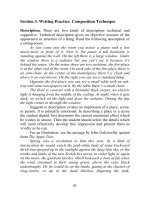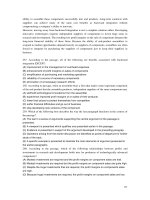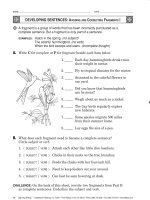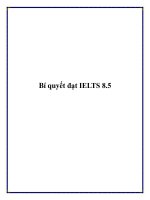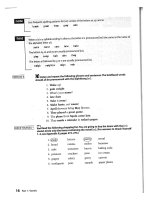Pronunciation guide 1, 8 5 13
Bạn đang xem bản rút gọn của tài liệu. Xem và tải ngay bản đầy đủ của tài liệu tại đây (383.29 KB, 54 trang )
LANE’S
ENGLISH
Pronunciation Guide
by
Richard R. Lane, Ph.D.
i
Copyright © 1977; revised 1988, 2000 by Richard R. Lane
All rights reserved. No part of this book may be changed
without written permission from the publisher.
The world’s most efficacious method for teaching English pronunciation is freely
give to all students and teachers byLane Press
P.O. Box 17822
Stanford, CA 94305
USA
ii
PREFACE
Lane’s English Pronunciation Guide is a drill book designed for learners of English as a
Second Language. It has two sections: Consonants and Vowels.
The consonants and vowels give practice in the pronunciation of 40 distinct English sounds.
Each phoneme is indicated by the International Phonetic Alphabet, accompanied by a list of
alternative English spellings. There is also a diagram for each sound, showing the position of
the tongue, teeth and lips, and indicating whether the sound is voiced or voiceless, i.e., whether
or not it has a vibration. The correct positioning of the tongue and other speech organs is vital
to clear pronunciation, therefore, the diagrams should be used as constant reminders when
working on minimal pairs.
The words in the drills form a large part of the vocabulary found in Dr. Lane’s text series
entitled Lane’s English as a Second Language. When used together, the Pronunciation
Guide and the texts provide the learner with continual cross reinforcement of words and
sounds.
iii
iv
CONTENTS
Preface ......................................................................................................................... iii
Diagram of speech organs ......................................................................................... vi
CONSONANTS
s
z
f
v
t
d
l
r
T
D
p
b
k
g
hw
w
S
Z
tS
dZ
m
n
k
h
j
(sea) ................................................................................................................... 2
(zebra) ................................................................................................................ 3
(foot) ................................................................................................................... 4
(vase) ................................................................................................................. 5
(time) .................................................................................................................. 6
(dog) ................................................................................................................... 7
(leaf) ................................................................................................................... 8
(rain) ................................................................................................................... 9
(theater) ............................................................................................................ 10
(the) .................................................................................................................. 11
(page) ............................................................................................................... 12
(bone) ............................................................................................................... 13
(key) ................................................................................................................. 14
(goat) ................................................................................................................ 15
(wheel) .............................................................................................................. 16
(wave) ............................................................................................................... 17
(shoe) ............................................................................................................... 18
(garage) ............................................................................................................ 19
(chair) ............................................................................................................... 20
(jeep) ................................................................................................................ 21
(moon) .............................................................................................................. 22
(nose) ............................................................................................................... 23
(king) ................................................................................................................ 24
(hair) ................................................................................................................. 25
(yes) ................................................................................................................. 26
VOWELS
e
Q
i
I
aI
E
o
ç
´
A
aU
çI
u
U
ju
(ate ................................................................................................................... 28
(at) .................................................................................................................... 29
(eel) .................................................................................................................. 30
(ill) ..................................................................................................................... 31
(night) ............................................................................................................... 32
(net) .................................................................................................................. 33
(own) ................................................................................................................ 34
(on) ................................................................................................................... 35
(nut) .................................................................................................................. 36
(not) .................................................................................................................. 37
(cow) ................................................................................................................. 38
(coy) ................................................................................................................. 39
(wooed) ............................................................................................................ 40
(wood) .............................................................................................................. 41
(you) ................................................................................................................. 42
-er/ir/ur/or .......................................................................................................... 43
-ed ......................................................................................................... 44
v
SPEECH ORGANS
Voiced sounds are produced with the vocal cords nearly closed and vibrating. Voiceless
sounds are made with the vocal cords open. In the profile diagrams, a vibrating line
indicates that the sound is voiced; dashes
indicate that it is voiceless.
Where production of the sound involves movement of the tongue, lips, or jaw, the starting
position is shown by a solid line, the direction of movement by an arrow, and the final
position by a broken line.
vi
LESSON FORMAT
The standard lesson is designed for 30 minutes. The teacher may begin by saying the sound
several times and then pointing out its alternative spellings at the top of the page. Using the
diagram, the teacher should indicate the position of the lips, teeth and tongue, and whether
the sound is voiced or voiceless.
Beginning with the six proper nouns under the diagram, the teacher should pronounce each
word clearly and have the students repeat in unison. Then each student should have the
opportunity to say the words individually.
Where possible each sound is given in its initial, medial and final positions. Because it is
easier to hear and then reproduce the sound if it is relatively isolated at the beginning and end
of a word, it is recommended that the following order of presentation be used:
1. initial
2. final
3. medial
In presenting each phoneme, the teacher should go down a column of words modeling each
of them and letting the students repeat in unison. Finally each student should pronounce the
column individually. Except in advanced classes, it is recommended that little attention be
given to word meaning. Teachers should point out that what is important is the sound. This, of
course, may vary from class to class and with a teacher’s particular style.
At the bottom of each page, there is a list of minimal pairs which provides a contrastive
exercise between easily confused sounds. By this time, students have heard the sound (in
the majority of cases) in at least 42 different words so their ability to reproduce and discriminate it from other sounds should be much higher than when they began the exercise. Students may find it helpful if the teacher pronounces the pure sounds before each of them gives
his recitation of the pairs. For example, the teacher may say s-z, s-z, s-z (as sounds, not as
letters), before a student attempts see-z, seal-zeal, sink-zinc, etc. The teacher should stress
the difference between the voiced and voiceless pairs.
Page 43 gives practice with r including discrimination between far, fair, fear, and for. Page 44
deserves special attention because it deals with the voiced and unvoiced pronunciation of d
at the end of words.
vii
TEACHING HINTS
1. Give your students a good model of pronunciation to follow.
2. Let your students see your mouth when you speak.
3. Do not jump from one exercise to another. Work on one phoneme at a time. Remember that for a
student to achieve his goal of accurate pronunciation, he must first hear the sound correctly and understand its proper articulation. This takes time, patience and drilling.
4. Do not be overly demanding about a student’s pronunciation the first few times. If a student can not
reproduce the sound, you may stop, go over the articulation, give a couple of distinct examples, and/or
make a contrast with a similar, but different sound. Failure to reproduce a sound can easily lead a
student to frustration. A good teacher will stop well before this point. Remember that repetition is the
mother of learning, so after identifying a few sounds that are difficult for your class, repeat them frequently during the course.
5. Note the students with the best pronunciation and always begin with them during the individual
recitations. This allows the weaker ones to hear the sound several times before their turn.
6. Use the diagrams to indicate the position of the tongue, teeth and lips. Be very careful that your
students position these organs correctly, for if you do not, they will not be able to reproduce the quality
of sound necessary to speak without an accent. For example, most languages have the sound of “d”
but in making this sound some speakers put their tongues behind their teeth and some put them far up
on the roof of their mouths. English speakers put theirs on the gum ridge directly above the front teeth.
Each position gives a different quality “d.” A student who wants to speak English correctly must, therefore, position his tongue accordingly. Be patient, but demanding. Your students will thank you.
7. Explain that some sounds have a vibration in the throat and some do not. Those with a vibration
(voiced sounds) are indicated in the text with
and those without a vibration (voiceless sounds) are
shown with
in the diagrams. The vibration may be felt by placing the hand on the throat. The
presence or absence of the vibration is extremely important, because it is the only difference between
the pronunciation of the following pairs:
voiceless:
voiced:
s
z
f
v
t
d
T
D
p
b
k
g
hw
w
S
Z
tS
dZ
8. Cognizance of the difference between voiced and voiceless sounds will aid learners in avoiding a
very serious mistake. Speakers of Indo-European language have a marked tendency to unvoice final
voiced consonants. When this is done in English, it causes cab to become cap, bed - bet, pig - pick,
save - safe, his - hiss, edge - etch, etc. It is thus very important for students to learn to voice final voiced
consonants.
9. A second mistake to avoid is in the pronunciation of p, t and k. English, in contrast to many other
languages, requires a light puff of air (aspiration) when these voiceless consonants are found, especially at the beginning and end of words (pipe, tent, kick). Failure to aspirate gives a flat effect to
English pronunciation. The strong aspiration that we give these sounds can be demonstrated by pronouncing them while holding a sheet of paper in one hand about two inches from the mouth.
10. Some languages, particularly Italian and Japanese, have very few final consonant sounds. When
speakers of such languages pronounce English words with final constants, one often seems to hear
an extra “a,” for example: cab-a, road-a, bag-a. In fact, what is happening is the speaker is releasing
the consonant before the air flow stops. This tendency may be corrected by holding, or not
releasing the consonant until the air flow stops. This solution works best with final voiced consonants.
viii
Although some linguists apply the same remedy to voiceless ones, this author feels that the aspiration of final voiceless consonants gives a desirable crispness to pronunciation and produces a clear
distinction between can and can’t, did and didn’t, ten and tent, etc.
11. Sounds may be divided into three groups: consonants, vowels and diphthongs.
CONSONANTS may be subdivided into
A. PLOSIVES - sounds that are stopped abruptly: p, b, t, d, k, g, tS, dZ
B. CONTINUANTS - sounds that may continue as long as the breath lasts:
1. fricatives- sounds made by forcing air through a narrow space causing friction: f, v, w, hw, h,
r, D, T
2. sibilant fricatives- sounds with a whistle: s, z, S, Z
3. nasal continuants- sounds made by the passage of air through the nose: m, n, N
4. lateral continuant- sound made by the passage of air around the sides of the tongue: l
5. semi-consonants (or semi-vowels)- free-flowing sounds with a vowel-like quality: ju, j
VOWELS are unobstructed voiced sounds. They are often classified according to the position of the
tongue. The sounds may be made on the FRONT, MIDDLE, or BACK of the tongue which may be in
a high, medium, or low position.
FRONT
high
medium
low
MIDDLE
i
I
E
Q
(eel)
(it)
(edge)
(atom)
´
(up, mama)
u
U
ç
A
(shoe)
(book)
(author)
(ox)
BACK
high
medium
low
DIPHTHONGS or glides are a combination of two vowel sounds. They may be shown to progress
from the high front of the tongue to the low back.
FRONT
j
ju
e
aI
(yes)
(youth)
(ape)
(ice)
BACK
çI
o
aU
(oil)
(oak)
(out)
ix
ACCENT IMPROVEMENT- Two frequently heard defects in English pronunciation are:
1. a slurring and/or
2. a staccato ta-ta-ta-ta quality
The first problem, slurring, is often heard from speakers of languages that encourage a liaison between
the end of one word and the beginning of the next. When this is done in English the result is quite
undesirable. The English ear does not expect musical or lyrical qualities; it responds to crispness. We
like to hear one word end before the next begins. Not only are the consonant endings of many words a
definite obstacle to linking, intelligibility demands their clear articulation. We want and need to hear a
difference between:
14
160
can
be
pour
40
1/60
can’t
beef
pork
ask
be in
faint
asked
prints
being
fainted
To achieve the desired crispness, we have to cut words from one another by giving full value to consonant endings. Exaggeration is not unwarranted, because the student will naturally reduce it.
The second problem, a staccato quality, comes from the fact that in most languages vowels are given
equal stress so that every syllable has equal value. Stress within the words is achieved by accentuating a particular syllable. When English is spoken in this fashion, the result is a computer-like output.
In English, all syllables of a word are not given equal stress. Rather the stressed syllable is elongated.
This results in the deformation of other vowels, often turning them into mere shwas: ´. Thus, students
of English must learn to elongate or stretch the vowels, rather than raise their voices, at the stress point
of words. For example:
instead of
da
re co men /\ tion,
re co men daaa tion
tu
con sti /\ tion,
con sti tuuu tion
fri
re /\ ge ra tor,
teach
re friii ge ra tor
a
pro nun ci /\ tion,
pro nun ci aaa tion
sen
re pre /\ ta tive,
re pre seeen ta tive
At first, this may sound like encouraging a “cowboy” style of speech, but given the natural inclination
of students to shorten and equalize all syllables, we must exaggerate the elongation in practice.
PRACTICAL TIPS:
1. Have students color the tongue in the diagrams with a highlighter pen to emphasize its position.
2. Have students use a pink or yellow highlighter pen to color code voiced consonants. This may
also be done with reading passages to visually reinforce the need to voice many final consonants.
x
CONSONANTS
1
Put the teeth together, edge to edge. Keep the tongue flat and release a
VOICELESS stream of air. Do not let the tongue touch the teeth.
sea
glass
base
city
ice
science
psalm
sword
waltz
2
Samuel
Saturday
Spain
Susan
Sunday
Sweden
say
sane
see
seen
sigh
sign
so
sown
sue
soon
soup
suit
also
pencil
muscle
person
mister
lesson
answer
history
bracelet
possible
necessary
responsible
base
face
race
piece
peace
niece
ice
rice
nice
close
glass
force
s
z
-
s
s
z
sea
seal
sink
sip
sue
z
zeal
zinc
zip
zoo
bay
knee
eye
dough
do
base
niece
ice
dose
deuce
race
niece
ice
close
use
rays
knees
eyes
close
use
Put the teeth together, edge to edge. Keep the tongue flat and release a VOICED
stream of air. Do not let the tongue touch the teeth.
zero
jazz
doze
easy
raise
scissors
xylophone
Zachary
Zaire
Zurich
Zena
Zambia
Zagreb
zeal
zone
zoo
zoom
zinc
zest
zero
zebra
zipper
zodiac
zenith
zigzag
easy
lazy
crazy
visit
music
poison
result
season
museum
cousin
husband
opposite
pays
rays
please
freeze
these
those
rose
clothes
is
his
was
does
s
z
-
s
s
z
see
seal
sink
sip
sue
zeal
zeal
zinc
zip
zoo
ray
bee
eye
no
new
rays
bees
eyes
nose
news
race
cease
ice
dose
loose
rays
seas
eyes
doze
lose
3
Put the upper teeth firmly on the lower lip and force out a VOICELESS stream of air.
foot
phone
suffer
life
enough
4
Philip
February
Florida
Frances
Friday
France
face
fame
feet
feel
fine
file
foam
phone
food
fool
far
for
left
soft
after
before
coffee
office
effect
defeat
profit
different
beautiful
telephone
if
off
safe
leaf
beef
life
knife
loaf
roof
laugh
rough
enough
f
v
-
f
f
v
face
feel
fine
few
fairy
vase
veal
vine
view
very
say
be
lie
low
shell
safe
beef
life
loaf
shelf
safe
leaf
life
half
proof
save
leave
live
have
prove
Put the upper teeth firmly on the lower lip and force out a VOICED stream of air.
very
of
have
Stephen
Victor
Vermont
Venezuela
Virginia
Vietnam
Venice
vase
veil
veal
vice
vine
vote
view
very
vast
voice
visit
vodka
over
civil
every
silver
living
private
envelope
division
invitation
television
university
development
of
wave
save
leave
five
live
stove
cove
have
give
love
nerve
f
v
-
v
f
v
face
feel
fine
few
fairy
vase
veal
vine
view
very
say
way
lee
lie
dough
save
wave
leave
live
dove
saf e
leaf
life
half
proof
save
leave
live
have
prove
5
Put the end of the tongue firmly against the roof of the mouth (not on the teeth!) and
then suddenly release it, letting a VOICELESS stream of air escape.
to
button
date
asked
Thames
debt
indict
yacht
receipt
might
6
Thomas
Tuesday
Thailand
Teresa
Texas
Turkey
take
tape
tea
team
tie
time
toe
tone
too
tool
tooth
tongue
metal
letter
detail
writing
meeting
between
country
history
victory
interest
military
political
date
wait
meat
seat
light
right
coat
boat
root
suit
boot
but
t
d
-
t
t
d
tea
tie
time
toe
to
d
die
dime
dough
do
ray
be
tie
row
shoe
rate
beat
tight
wrote
shoot
mate
seat
right
coat
root
made
seed
ride
code
rude
Put the end of the tongue firmly against the roof of the mouth (not on the teeth!)
and then suddenly release it, letting a VOICED stream of air escape.
day
sudden
made
moved
should
David
December
Detroit
Diana
Delaware
Denmark
day
date
deep
deal
die
dial
dough
dome
do
doom
dog
does
body
ready
order
under
medal
middle
credit
sudden
powder
window
seldom
shoulder
raid
fade
made
read
feed
seed
ride
tide
side
road
load
code
t
d
-
d
t
d
tea
tie
time
toe
to
d
die
dime
dough
do
ray
be
tie
row
few
raid
bead
tied
rode
feud
mate
seat
right
coat
root
made
seed
ride
code
rude
7
Make the tongue hard. Put it very firmly on the roof of the mouth, high above the
teeth. Let a VOICED stream of air escape around its sides.
long
tall
mile
8
Louis
Lebanon
Laos
Lisa
Louisiana
Liberia
late
lake
leaf
leak
life
like
low
loan
loose
loop
less
lip
belt
salt
milk
along
color
salad
early
family
feeling
ceiling
building
bracelet
sale
nail
heel
meal
mile
file
hole
coal
ball
fall
call
tall
l
r
-
l
l
r
late
lead
light
low
loom
rate
read
right
row
room
ray
he
my
hoe
do
rail
heel
mile
hole
duel
foal
mole
stole
oval
feel
for
more
store
over
fear
Put the tongue exactly as for l, but do not touch the roof of the mouth. Or, make
an l and break the contact with the roof of the mouth. Let a VOICED stream of
air escape.
red
correct
more
write
rhyme
Richard
Russia
Rumania
Rose
Rhine
Rome
rake
rain
read
real
right
ride
row
road
room
root
red
ready
dark
park
heart
part
cart
start
horn
corn
born
horse
force
course
or
for
more
are
car
far
air
hair
chair
ear
here
beer
l
r
-
r
l
r
late
lead
light
low
loom
rate
read
right
row
room
allay
elect
collect
believe
ceiling
array
erect
correct
bereave
searing
foal
mole
stole
oval
feel
for
more
store
over
fear
9
Put the end of the tongue between the upper and lower front teeth and release a
VOICELESS stream of air.
think
10
Theodore
Thursday
Katherine
Thelma
Nathaniel
Elizabeth
thin
think
thick
thank
thumb
thing
throat
theory
thought
theater
thunder
thousand
ether
ethnic
method
author
healthy
wealthy
athlete
pathetic
ruthless
birthday
cathedral
something
with
bath
path
both
birth
earth
tooth
mouth
south
north
growth
fourth
s
T
-
T
s
T
sank
sink
sick
sing
some
thank
think
thick
thing
thumb
six
seven
eight
nine
ten
sixth
seventh
eighth
ninth
tenth
use
pass
mouse
force
gross
youth
path
mouth
fourth
growth
Put the end of the tongue between the upper and lower front teeth and release
a VOICED stream of air.
the
bathe
they
thee
these
thy
though
those
the
then
them
this
that
there
other
mother
father
brother
rather
leather
feather
weather
farther
together
northern
southern
bathe
scathe
teethe
seethe
breathe
sheathe
wreathe
tithe
clothe
loathe
soothe
smooth
D
d
-
D
D
s
they
thee
thy
though
those
day
d
die
dough
doze
bay
tea
tie
low
sue
bathe
teethe
tithe
loathe
soothe
they
thee
thy
though
that
say
see
sigh
so
sat
this claim
this place
this taste
this favor
this color
disclaim
displace
distaste
disfavor
discolor
the fame
the base
the bait
the vice
the spies
defame
debase
debate
device
despise
11
Press the lips together tightly, then release a VOICELESS puff of air.
pay
support
rope
hiccough
12
Peter
Poland
Peru
Patricia
Portugal
Pakistan
pay
pain
page
pea
piece
peace
pie
pine
pose
pole
push
pull
copy
open
happy
apple
expert
company
support
capital
opposite
hospital
expensive
comparison
ape
tape
keep
cheap
sheep
hope
soap
rope
type
ripe
soup
step
p
b
-
p
p
b
pay
pea
pie
pole
push
bay
bee
by
bowl
bush
a
key
tie
so
sue
ape
keep
type
soap
soup
cap
cup
cop
rip
rope
cab
cub
cob
rib
robe
Press the lips together tightly, then release a VOICED puff of air.
be
rabbit
robe
cupboard
Benjamin
Boston
Bolivia
Barbara
Belgium
Brazil
bay
base
bait
be
bean
beach
by
bite
bone
boat
boom
boot
able
table
double
trouble
public
harbor
library
subject
rabbit
husband
member
number
lab
cab
crab
stab
rub
tub
cub
pub
job
sob
mob
rob
p
b
b
v
p
b
pay
pea
pie
pole
push
bay
be
by
bowl
bush
base
b
bile
boat
berry
vase
v
vile
vote
very
cap
cup
cop
rip
rope
cab
cub
cob
rib
robe
13
Put the back of the tongue up until it touches the soft palate and stops the stream of
air. Release the stop with a little VOICELESS puff of air.
keep
candle
account
queen
school
sack
walk
make
ache
khaki
14
Kenneth
California
Korea
Katherine
Canada
Kenya
came
case
cake
key
keep
kite
kind
coat
comb
cool
cat
cow
uncle
doctor
secret
broken
liquid
market
fiction
picture
factory
necklace
breakfast
make
take
week
weak
coke
soak
like
bike
back
bank
book
work
k
g
-
k
k
g
came
coat
cold
come
could
game
goat
gold
gum
good
may
we
lie
so
do
make
week
like
soak
duke
back
rack
tack
sack
lack
bag
rag
tag
sag
lag
Put the back of the tongue up until it touches the soft palate and stops the stream
of air. Release the stop with a little VOICED puff of air.
good
foggy
guest
ghost
Gary
God
Ghana
Gladys
Greece
Guatemala
gate
gain
guy
guide
go
goat
gas
gun
get
give
girl
good
ago
again
begin
cigar
foggy
sugar
degree
forget
finger
regular
against
together
dog
jog
log
fog
egg
leg
bag
rag
bug
rug
big
pig
k
g
g
N
k
g
came
coat
cold
come
could
game
goat
gold
gum
good
bag
gag
log
wig
rug
bang
gang
long
wing
rung
buck
muck
tuck
luck
duck
bug
mug
tug
lug
dug
15

